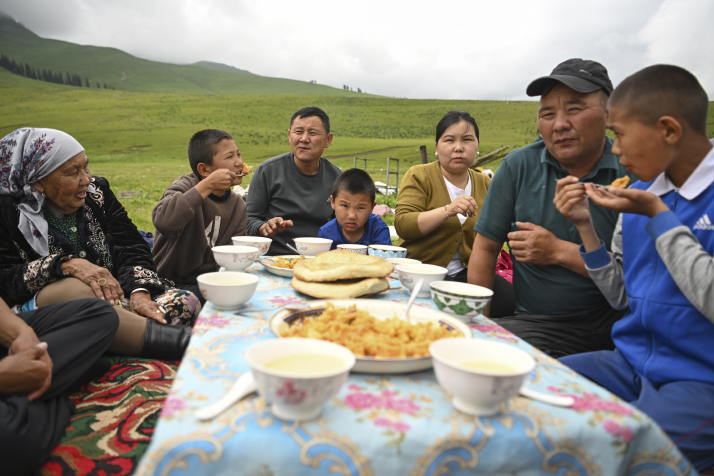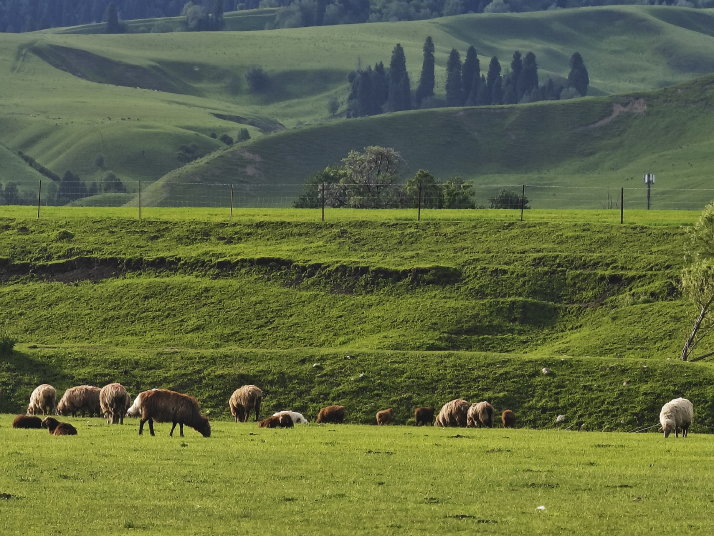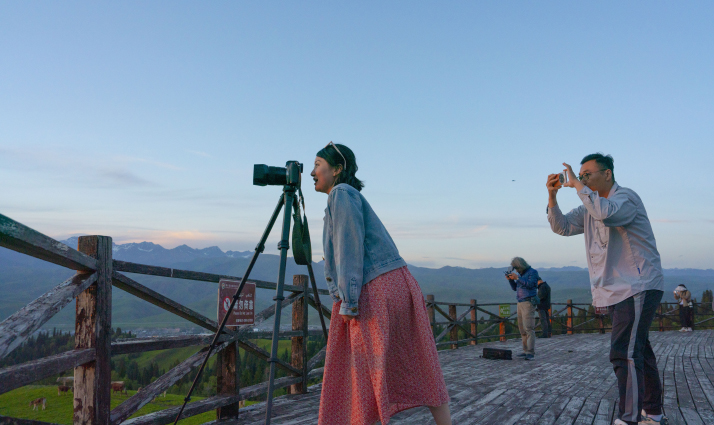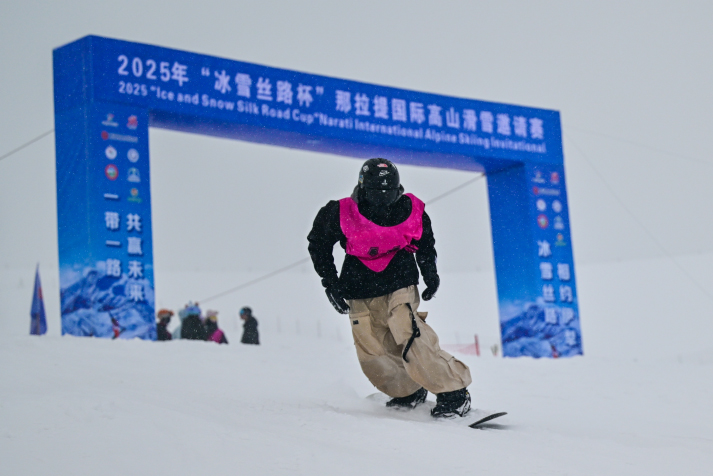| Xinjiang Today |
| The Nalati Grassland: a jewel of nature and culture | |
|
|
 A Kazak family have lunch at their summer pasture in Nalati on June 11 (XINHUA)
Over 700 years ago, during his westward expedition, Genghis Khan and his army found themselves lost in the snowy expanse of the Tianshan Mountains. Battling hunger and exhaustion, they trudged through the harsh terrain until the horizon suddenly opened, revealing a vast grassland. As the skies cleared and sunlight bathed the earth, the warriors exclaimed in unison, "Narat!"—meaning "Here comes the sun!" in the Mongolian language. Since then, the land has been known as Narat, or Nalati, the first place to be embraced by the sun.  Animals graze in the Nalati Grassland (VCG)
An iconic grassland
Nalati Town in Ili Kazak Autonomous Prefecture, home to approximately 30,000 residents, is known for its natural beauty, and most notably, the Nalati Grassland. The grassland, located in a river valley, is one of the world's best known alpine river valley grasslands. Enclosed by the vast Tianshan Mountains, its lush green pastures flourish due to abundant rainfall brought by the westerly winds. The grassland is ideal for livestock grazing and has long served as a summer pasture. It is also a natural retreat, with a cool, refreshing climate and a striking landscape. In 2005, the Nalati Grassland won recognition as the grassland home to the largest Kazak community. Each summer, starting from June, Kazak herders host traditional festivals on the picturesque grassland, creating an atmosphere of harmony and authentic Kazak culture. For centuries, Kazak herders have followed their ancestral tradition, moving with their livestock between pastures as the seasons change. Although many have settled into permanent homes today, this age-old practice remains vital, ensuring the grasslands lie idle and rejuvenate and their animal husbandry can continue. In 2009, the tradition of Kazak herding migration was recognized as part of Xinjiang's intangible cultural heritage. These seasonal migrations add to the cultural richness, unique to Xinjiang. The grassland's rolling hills, proximity to deserts and snowy peaks, create a mesmerizing contrast. It is not just a natural gem but also a cultural treasure, showcasing the timeless connection between the land and the people.  Tourists take pictures of the Nalati Grassland on May 22 (XINHUA)
Tourism hub "It all started with two tents. I never imagined I'd make over 20,000 yuan ($2,790) in just three months." Mazhatibieke Ajibieke, a resident of Nalati Town, was one of the first locals to benefit from tourism. In 2005, during Nalati's first large-scale Naadam Festival, a traditional sports and entertainment gathering held by the Mongolians as well as the Kazaks, he decided to try his luck by erecting two tents for campers. To his surprise, his modest venture earned him over 20,000 yuan in a single season, opening his eyes to the opportunities in tourism and marking the beginning of his journey toward prosperity. The history of Nalati's tourism traces back to 1990, when the first reception center, the Nalati Grassland Tourism Center, was established. In 1999, the Nalati Scenic Area was founded, and by 2002, ticket sales began. That year, the total revenue barely exceeded 300,000 yuan ($42,000). However, the turning point came in 2011, when the scenic area was designated a national 5A tourist attraction, the highest rating in China's tourism industry. The Overall Plan for the Nalati Tourist Resort (2015-30) provides a strategic framework for rapid growth. Reflecting on this transformation, Wang Suwen, a staff member at the scenic area, remarked in a 2024 interview, "What started as a lush grassland attracting visitors for its natural beauty has become a powerful tourism destination, welcoming millions of domestic and international tourists each year."  A skier competes in an alpine skiing competition in Nalati on March 1 (XINHUA)
Diverse experience Tourist experiences in Nalati have undergone remarkable changes over the years. What began as simple sightseeing and photography has evolved into a rich variety of activities, including horseback riding, wedding customs performances, micro-film shooting and visits to cultural attractions like the Wusun Ancient Street, which showcases the culture of the ancient Wusun State some 2,000 years ago. Transportation options have also expanded, from basic tour buses to luxury helicopter rides, drift rafting and snowmobile adventures. Once a summer and autumn destination, Nalati now offers winter activities like skiing, snow-capped mountain tours and hot spring visits. In recent years, the scenic area has transformed from a single-function sightseeing area to an integrated leisure, vacation and entertainment destination. In 2023, the launch of its winter skiing program completed its evolution into a year-round travel destination.  Hotel Indigo in Nalati (INDIGO OFFICIAL WEBSITE) Catalyst for prosperity Hotel Indigo in Nalati, a star-rated hotel inspired by the Kazak nomadic culture, is the latest addition to Nalati's hospitality scene, opening on July 1. "We will enhance Nalati's image and contribute to the development of modern service industries, ultimately creating a better and happier life for the community," the hotel's General Manager Liu Juquan promised during the hotel's inauguration. The InterContinental Hotels Group, which owns the hotel, has also opened the Holiday Inn Express Nalati. Nalati's tourism industry has become the driving force behind regional prosperity, fueling growth across multiple sectors. In 2023, the tourism revenue in Xinyuan County, helped by the Nalati Scenic Area, surpassed 10 billion yuan ($1.4 billion), contributing significantly to Ili's goal of building a 1-trillion-yuan ($139-billion)tourism economy. Nalati Town is part of Xinyuan County, one of the 11 counties and cities in Ili. In recent years, the town has focused on revitalizing idle land and housing resources, and promoting rural homestay tourism and public camping projects to boost village incomes. Residents are encouraged to develop mid-to-high-end homestays, sharing benefits brought by tourism and improving their livelihoods. Homestay operators are incentivized to explore innovative models such as "homestay plus photography," "homestay plus stargazing" and "homestay plus ethnic dance performances," integrating cultural elements to elevate the tourism experience. Riding on the Nalati Scenic Area brand, Xinyuan has developed a diversified tourism framework that interconnects its towns. It features health and wellness tourism in Nalati, cold-water fish farming and raspberry picking in Kansu, rural vacations in Alemale and liquor culture tours in Xiaoerbulake. This multifaceted approach has fostered a collaborative and sustainable tourism industry. In 2024, Xinyuan welcomed over 20 million tourist trips, generating tourism revenue of nearly 14.1 billion yuan ($2 billion)—a year-on-year increase of 17.66 percent and 34.25 percent, respectively. The efforts of its residents have propelled Nalati's transformation from a mere scenic attraction to a holistic, integrated tourism destination. Comments to yanwei@cicgamericas.com |
|
||||||||||||||||||||||||||||
|